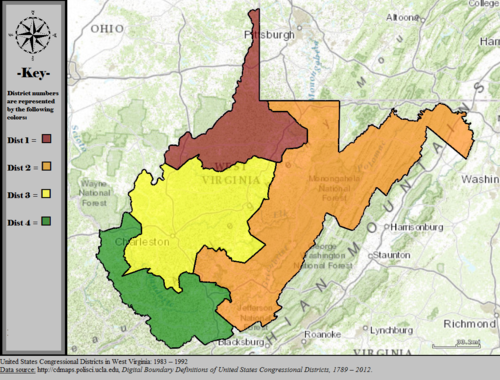
Interactive map version
The U.S. state of West Virginia currently has two congressional districts, each represented by a member of the United States House of Representatives.

The U.S. state of West Virginia currently has two congressional districts, each represented by a member of the United States House of Representatives.
This is a list of United States representatives from West Virginia, district boundaries, and the district political ratings according to the CPVI. The delegation has a total of two members, both of whom are Republicans.
| Current U.S. representatives from West Virginia | |||||
|---|---|---|---|---|---|
| District | Member (Residence) [1] | Party | Incumbent since | CPVI (2025) [2] | District map |
| 1st |  Carol Miller (Huntington) | Republican | January 3, 2019 | R+22 |  |
| 2nd |  Riley Moore (Harpers Ferry) | Republican | January 3, 2025 | R+20 |  |

Table of United States congressional district boundary maps in the State of West Virginia, presented chronologically. [3] All redistricting events that took place in West Virginia between 1973 and 2013 are shown.
| Year | Statewide map |
|---|---|
| 1973–1982 |  |
| 1983–1992 |  |
| 1993–2002 |  |
| 2003–2013 |  |
| 2013–2023 |  |
The 3rd district was eliminated by the 2020 United States census.
The 4th district was eliminated by the 1990 United States census.
The 5th district was eliminated by the 1970 United States census.
The 6th district was eliminated by the 1960 United States census.
West Virginia's at-large congressional district existed between 1913 and 1917, during a period when the state failed to enact a redistricting plan that allowed for a new sixth district. Such a plan was adopted for the 1916 elections, making the at-large seat obsolete.